Epson Stylus Pro 7880, Stylus Pro 9880, Stylus R2000, Stylus R2880, Stylus R3000 Managing Color Guide
...
Epson® Professional Imaging
Managing Color
Printing with ICC Profiles
Copyright Notice
All rights reserved. No part of this publication may be reproduced, stored in a retrieval system, or transmitted in any form or by any means, electronic, mechanical, photocopying, recording, or otherwise, without the prior written permission of Seiko Epson Corporation. The information contained herein is designed only for use with this Epson product. Epson is not responsible for any use of this information as applied to other equipment.
Neither Seiko Epson Corporation nor its affiliates shall be liable to the purchaser of this product or third parties for damages, losses, costs, or expenses incurred by purchaser or third parties as a result of: accident, misuse, or abuse of this product or unauthorized modifications, repairs, or alterations to this product, or (excluding the U.S.) failure to strictly comply with Seiko Epson Corporation’s operating and maintenance instructions.
Seiko Epson Corporation shall not be liable for any damages or problems arising from the use of any options or any consumable products other than those designated as Original Epson Products or Epson Approved Products by Seiko Epson Corporation.
Responsible Use of Copyrighted Materials
Epson encourages each user to be responsible and respectful of the copyright laws when using any Epson product. While some countries’ laws permit limited copying or reuse of copyrighted material in certain circumstances, those circumstances may not be as broad as some people assume. Contact your legal advisor for any questions regarding copyright law.
Trademarks
EPSON and Epson Stylus are registered trademarks, and EPSON Exceed Your Vision is a registered logomark of Seiko Epson Corporation.
General Notice: Other product names used herein are for identification purposes only and may be trademarks of their respective owners. Epson disclaims any and all rights in those marks.
This information is subject to change without notice.
© 2013 Epson America, Inc. 7/13 |
CPD-39134 |
2

Introduction
For the most precise color in your prints, you can use profiles designed specifically for your printer model and paper type. Basic profiles are installed with your printer driver, and you may also have downloaded Premium ICC profiles from Epson when you installed your printer software.
To print using Premium ICC profiles with Adobe® Photoshop® CC, CS6, CS5, or Adobe Photoshop Lightroom®, follow the instructions in these sections for your operating system:
■“Windows 8 and Windows 7” below
■“Mac OS X 10.8 and 10.7” on page 20
Windows 8 and Windows 7
Follow the instructions in these sections:
■“Printing with Adobe Photoshop CC or CS6” below
■“Printing with Adobe Photoshop CS5” on page 8
■“Printing with Adobe Photoshop Lightroom” on page 14
Printing with Adobe Photoshop CC or CS6
First set up your color management environment in Photoshop and assign a profile to your image. Then select your print settings and print.
Note:
Assigning a profile to your image doesn’t alter it, only the interpretation of it by your software and how it appears on your monitor and in a printout. This is the best way to improve the color balance and contrast in your image.
Printing with Adobe Photoshop CC or CS6 3
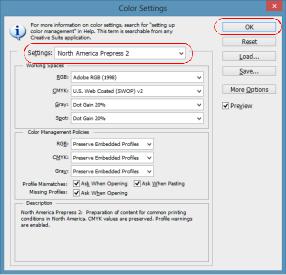
Setting Up the Photoshop Environment
1.Open Photoshop.
2.Select Edit > Color Settings.
3.Select North America Prepress 2 from the Settings menu to set Adobe RGB (1998) as the RGB working space and activate all profile messages.
4.Click OK.
Follow the steps in the next section to open the photo you want to print and assign a profile to it.
Assigning a Profile to Your Photo
1.Open the photo you want to print.
2.If you see an Embedded Profile Mismatch message, select Use the embedded profile (instead of the working space) and click OK.
4 Windows 8 and Windows 7
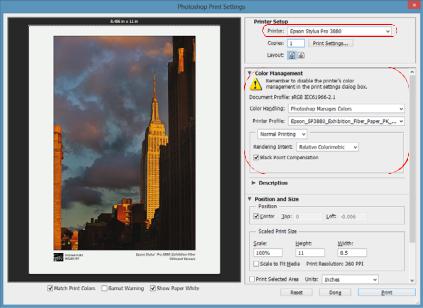
If you see a Missing Profile message, select
RGB (1998) and click OK. When your image appears, evaluate the color balance and contrast as displayed on your monitor. If it looks incorrect, select
Edit > Assign Profile.
Note:
If you see a dialog box regarding the appearance of layers, click OK.
Select one of the following as the Profile setting:
■A different RGB working space (or Profile), such as sRGB IEC61966-2.1
■A camera profile for your digital camera
■A scanner profile for your scanner
Also select the Preview checkbox so you can see the effects of your profile choice on the screen.
Tip:
This is most effective when your monitor is calibrated using a hardware device such as the X-Rite® ColorMunki™ Display, i1 Display Pro, or Datacolor® Spyder™.
3.Click OK.
4.Select File, then select Print.
5.Select your Epson professional printer in the Printer list.
Printing with Adobe Photoshop CC or CS6 5
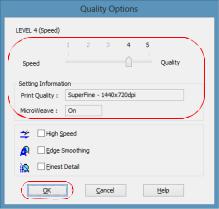
6.Under Color Handling, select Photoshop Manages Colors.
7.Under Printer Profile, select a profile for your printer and the paper you’ll use. If you’re printing with Epson Premium ICC profiles, select the profile that also matches the print quality you want to use.
8.For the Rendering Intent, select Relative Colorimetric.
Note:
If your image contains very saturated colors, select Perceptual. This reduces the color saturation so that the colors fit within the printer’s color gamut.
9.Select the Black Point Compensation checkbox.
10.Click the Print Settings button.
Follow the steps in the next section to select print settings to match the profile and print.
Printing Your Color-Managed Photo
1.Select the Source and Media Type settings for the paper you’ll use for the print.
2.Select Quality Options as the Print Quality setting. You see a window like this one:
3.If you are using an Epson Premium ICC profile, set the Print Quality setting to match your profile.
6 Windows 8 and Windows 7

4.Turn off the High Speed and Edge Smoothing options, if they are available, then click OK to close the Quality Options window.
5.Select Custom as the Mode setting, then choose Off (No Color Adjustment) from the drop-down menu.
Note:
Make sure that you select Off (No Color Adjustment). If you don’t, the printer driver will apply additional correction to the image, producing inaccurate results.
6. Click OK.
Printing with Adobe Photoshop CC or CS6 7
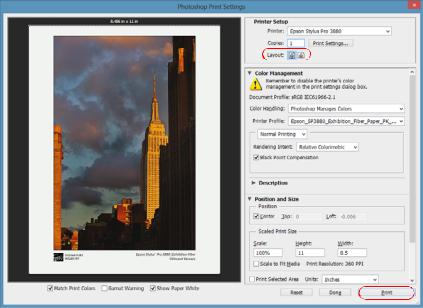
7. Select the correct orientation for your photo.
8. Click Print to print your photo.
If you get unexpected results, see “Solving Color Management Problems” on page 34.
Printing with Adobe Photoshop CS5
First set up your color management environment in Photoshop and assign a profile to your image. Then select your print settings and print.
Note:
Assigning a profile to your image doesn’t alter it, only the interpretation of it by your software and how it appears on your monitor and in a printout. This is the best way to improve the color balance and contrast in your image.
8 Windows 8 and Windows 7

Setting Up the Photoshop Environment
1.Open Photoshop.
2.Select Edit > Color Settings.
3.Select North America Prepress 2 from the Settings menu to set Adobe RGB (1998) as the RGB working space and activate all profile messages.
4.Click OK.
Follow the steps in the next section to open the photo you want to print and assign a profile to it.
Assigning a Profile to Your Photo
1.Open the photo you want to print.
2.If you see an Embedded Profile Mismatch message, select Use the embedded profile (instead of the working space) and click OK.
If you see a Missing Profile message, select Assign working RGB: Adobe RGB (1998) and click OK. When your image appears, evaluate the color balance and contrast as displayed on your monitor. If it looks incorrect, select
Edit > Assign Profile.
Printing with Adobe Photoshop CS5 9
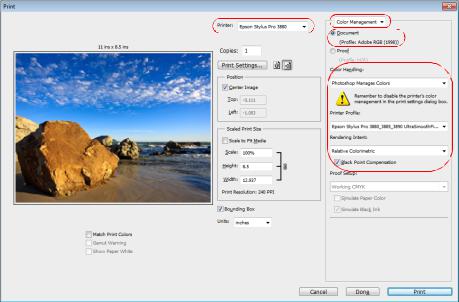
Select one of the following as the Profile setting:
■A different RGB working space (or Profile), such as sRGB IEC61966-2.1
■A camera profile for your digital camera
■A scanner profile for your scanner
Also select the Preview checkbox so you can see the effects of your profile choice on the screen.
Tip:
This is most effective when your monitor is calibrated using a hardware device such as the X-Rite ColorMunki Display, i1 Display Pro, or Datacolor Spyder.
3.Click OK.
4.Select File, then select Print.
5.Select your Epson professional printer in the Printer list, then select Color Management.
6.Under Color Handling, select Photoshop Manages Colors.
7.Under Printer Profile, select a profile for your printer and the paper you’ll use. If you’re printing with Epson Premium ICC profiles, select the profile that also matches the print quality you want to use.
10 Windows 8 and Windows 7
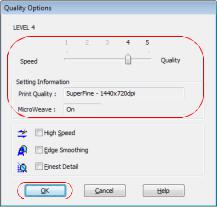
8. For the Rendering Intent, select Relative Colorimetric.
Note:
If your image contains very saturated colors, select Perceptual. This reduces the color saturation so that the colors fit within the printer’s color gamut.
9.Select the Black Point Compensation checkbox.
10.Click the Print Settings button.
Follow the steps in the next section to select print settings to match the profile and print.
Printing Your Color-Managed Photo
1.Select the Source and Media Type settings for the paper you’ll use for the print.
2.Select Quality Options as the Print Quality setting. You see a window like this one:
3.If you are using an Epson Premium ICC profile, set the Print Quality setting to match your profile.
4.Turn off the High Speed and Edge Smoothing options, if they are available, then click OK to close the Quality Options window.
Printing with Adobe Photoshop CS5 11
